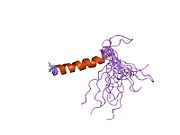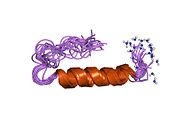Peptide YY
| PYY | |||
|---|---|---|---|
Gene ontology | |||
| Molecular function | |||
| Cellular component | |||
| Biological process | |||
| Sources:Amigo / QuickGO | |||
Ensembl | |||||||||
|---|---|---|---|---|---|---|---|---|---|
| UniProt | |||||||||
| RefSeq (mRNA) | |||||||||
| RefSeq (protein) | |||||||||
| Location (UCSC) | Chr 17: 43.95 – 44 Mb | Chr 11: 102 – 102 Mb | |||||||
| PubMed search | [3] | [4] | |||||||
| View/Edit Human | View/Edit Mouse |
Peptide YY (PYY), also known as peptide tyrosine tyrosine, is a peptide that in humans is encoded by the PYY
Dietary fibers from fruits, vegetables, and whole grains, consumed, increase the speed of transit of intestinal chyme into the ileum, to raise PYY3-36, and induce satiety. Peptide YY cannot be produced as the result of enzymatic breakdown of crude fish proteins and ingested as a food product.[7]
Structure
Peptide YY is related to the
.The PP-fold motif is found throughout this family and relates to the 3D structure. The PP-fold is formed through the incorporation of certain residues which are predominately Pro2, Pro5, Pro8, Gly9, Tyr20 and Tyr27. This PP-fold has been found to protect the peptide against enzymatic attack as well as producing a hydrophobic pocket which is inherently overall energy reducing. In addition to containing the PP-fold motif, PYY and its derivative PYY3- 36 also have a high C-terminal α-helix proportion, suggested to be extremely important for the structural integrity of PYY.[10]
Release
PYY is found in
PYY is released by the L-cells of the gastrointestinal tract following food intake, and there are two main endogenous forms: PYY1-36 and PYY3-36. PYY1-36 is rapidly processed by the enzyme
This could explain the reduced affinity for PYY3-36 on any other Y receptor other than Y2.[15] Other studies replacing the amide bonds with ester bonds also confirm that the end section is important in binding and activation.[16] The Y2 receptors are located in the hippocampus, sympathetic and parasympathetic nerve fibres, intestines, and certain blood vessels, and have been implicated in regulating food intake and gastric emptying.[17] As a result of this, the Y2 receptor is considered a target for the treatment of obesity and type II diabetes.
Function
PYY exerts its action through
Animal studies
Several studies have shown acute peripheral administration of PYY3-36 inhibits feeding of rodents and primates. Other studies on Y2R-knockout mice have shown no anorectic effect on them. These findings indicate PYY3-36 has an anorectic (losing appetite) effect, which is suggested to be mediated by Y2R. PYY-knockout female mice increase in body weight and fat mass. PYY-knockout mice, on the other hand, are resistant to obesity, but have higher fat mass and lower glucose tolerance when fed a high-fat diet, compared to control mice. Thus, PYY also plays a very important role in energy homeostasis by balancing food intake.[9] PYY oral spray was found to promote fullness.[19] Viral gene therapy of the salivary glands resulted in long-term intake reduction.[20]
Relevance to obesity
Leptin also reduces appetite in response to feeding, but obese people develop a resistance to leptin. Obese people secrete less PYY than non-obese people,[21] and attempts to use PYY directly as a weight-loss drug have met with some success. Researchers noted the caloric intake during a buffet lunch offered two hours after the infusion of PYY was decreased by 30% in obese subjects (p < 0.001) and 31% in lean subjects (p < 0.001).[22]
While some studies have shown obese persons have lower circulating level of PYY postprandially, other studies have reported they have normal sensitivity to the anorectic effect of PYY3-36. Thus, reduction in PYY sensitivity may not be one of the causes of obesity, in contrast to the reduction of leptin sensitivity. The anorectic effect of PYY could possibly be a future obesity drug.[9]
The consumption of protein boosts PYY levels, so some benefit was observed in experimental subjects in reducing hunger and promoting weight loss.[23] This could partially explain the weight-loss experienced with high-protein diets, noting also the high thermic effect of protein.
Obese patients undergoing gastric bypass showed marked metabolic adaptations, resulting in frequent diabetes remission 1 year later. When the confounding of calorie restriction is factored out, β-cell function improves rapidly, very possibly under the influence of enhanced
See also
References
![]() This article incorporates text by Jessica Hutchinson available under the CC BY 3.0 license.
This article incorporates text by Jessica Hutchinson available under the CC BY 3.0 license.
- ^ a b c GRCh38: Ensembl release 89: ENSG00000131096 – Ensembl, May 2017
- ^ a b c GRCm38: Ensembl release 89: ENSMUSG00000017311 – Ensembl, May 2017
- ^ "Human PubMed Reference:". National Center for Biotechnology Information, U.S. National Library of Medicine.
- ^ "Mouse PubMed Reference:". National Center for Biotechnology Information, U.S. National Library of Medicine.
- ^ EntrezGene 5697
- PMID 18987269.
- PMID 19073185.
- ISBN 978-0-7216-2888-2.
- ^ S2CID 1120344.
- PMID 6953409.
- PMID 3838162.
- S2CID 16104580.
- PMID 18406449.
- PMID 24251972.
- PMID 16819834.
- PMID 24900634.
- S2CID 7082920.
- PMID 8607584.
- ^ "UF researchers use oral peptide spray to stimulate weight loss in animals". Dec 19, 2013.
- PMID 22028819.
- S2CID 40358403.
- S2CID 11764433.
- PMID 16950139.
- PMID 24057293.
Further reading
- Ekblad E, Sundler F (February 2002). "Distribution of pancreatic polypeptide and peptide YY". Peptides. 23 (2): 251–261. S2CID 23262522.
- Sandström O, El-Salhy M (February 2002). "Ontogeny and the effect of aging on pancreatic polypeptide and peptide YY". Peptides. 23 (2): 263–267. S2CID 6661540.
- Yang H (February 2002). "Central and peripheral regulation of gastric acid secretion by peptide YY". Peptides. 23 (2): 349–358. S2CID 44727734.
- Naruse S, Kitagawa M, Ishiguro H, Hayakawa T (February 2002). "Feedback regulation of pancreatic secretion by peptide YY". Peptides. 23 (2): 359–365. S2CID 12150464.
- Aponte GW (February 2002). "PYY-mediated fatty acid induced intestinal differentiation". Peptides. 23 (2): 367–376. S2CID 37633831.
- Hagan MM (February 2002). "Peptide YY: a key mediator of orexigenic behavior". Peptides. 23 (2): 377–382. S2CID 11208314.
- Mannon PJ (February 2002). "Peptide YY as a growth factor for intestinal epithelium". Peptides. 23 (2): 383–388. S2CID 33363834.
- Tseng WW, Liu CD (February 2002). "Peptide YY and cancer: current findings and potential clinical applications". Peptides. 23 (2): 389–395. S2CID 38479590.
- El-Salhy M, Suhr O, Danielsson A (February 2002). "Peptide YY in gastrointestinal disorders". Peptides. 23 (2): 397–402. S2CID 45335940.
- Imamura M (February 2002). "Effects of surgical manipulation of the intestine on peptide YY and its physiology". Peptides. 23 (2): 403–407. S2CID 6023629.
- Beglinger C, Degen L (November 2006). "Gastrointestinal satiety signals in humans--physiologic roles for GLP-1 and PYY?". Physiology & Behavior. 89 (4): 460–464. S2CID 32598231.
- Eberlein GA, Eysselein VE, Schaeffer M, Layer P, Grandt D, Goebell H, et al. (1989). "A new molecular form of PYY: structural characterization of human PYY(3-36) and PYY(1-36)". Peptides. 10 (4): 797–803. S2CID 3857458.
- Facer P, Bishop AE, Cole GA, Aitchison M, Kendall CH, van Aswegen G, et al. (July 1989). "Developmental profile of chromogranin, hormonal peptides, and 5-hydroxytryptamine in gastrointestinal endocrine cells". Gastroenterology. 97 (1): 48–57. PMID 2721879.
- Tatemoto K, Nakano I, Makk G, Angwin P, Mann M, Schilling J, Go VL (December 1988). "Isolation and primary structure of human peptide YY". Biochemical and Biophysical Research Communications. 157 (2): 713–717. PMID 3202875.
- Lukinius AI, Ericsson JL, Lundqvist MK, Wilander EM (June 1986). "Ultrastructural localization of serotonin and polypeptide YY (PYY) in endocrine cells of the human rectum". The Journal of Histochemistry and Cytochemistry. 34 (6): 719–726. PMID 3517149.
- Adrian TE, Ferri GL, Bacarese-Hamilton AJ, Fuessl HS, Polak JM, Bloom SR (November 1985). "Human distribution and release of a putative new gut hormone, peptide YY". Gastroenterology. 89 (5): 1070–1077. PMID 3840109.
- Lundell I, Blomqvist AG, Berglund MM, Schober DA, Johnson D, Statnick MA, et al. (December 1995). "Cloning of a human receptor of the NPY receptor family with high affinity for pancreatic polypeptide and peptide YY". The Journal of Biological Chemistry. 270 (49): 29123–29128. PMID 7493937.
- Bard JA, Walker MW, Branchek TA, Weinshank RL (November 1995). "Cloning and functional expression of a human Y4 subtype receptor for pancreatic polypeptide, neuropeptide Y, and peptide YY". The Journal of Biological Chemistry. 270 (45): 26762–26765. PMID 7592911.
- Hort Y, Baker E, PMID 7782089.
- Kohri K, Nata K, Yonekura H, Nagai A, Konno K, Okamoto H (June 1993). "Cloning and structural determination of human peptide YY cDNA and gene". Biochimica et Biophysica Acta (BBA) - Gene Structure and Expression. 1173 (3): 345–349. PMID 8318545.
External links
- Peptide+YY at the U.S. National Library of Medicine Medical Subject Headings (MeSH)





